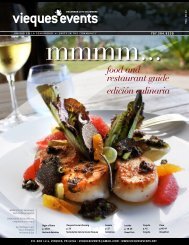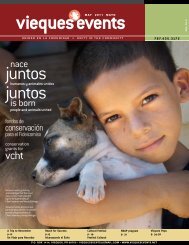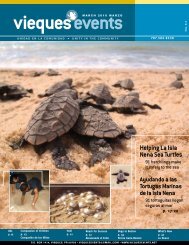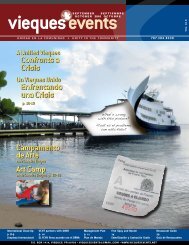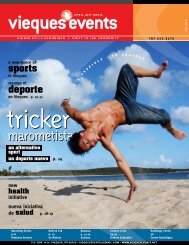Create successful ePaper yourself
Turn your PDF publications into a flip-book with our unique Google optimized e-Paper software.
eL CanTO<br />
De aMOR De LOS<br />
COquieS<br />
MaChO<br />
The LOVe<br />
SOnG<br />
OF MaLe<br />
COquieS<br />
usualmente, el aire nocturno se impregna con la canción de<br />
amor del Coquí. estos cantos de amor provienen de los<br />
sacos vocales de estas especies. en <strong>Vieques</strong> se encuentran<br />
tres especies; la más pequeña de estos anfibios nativos es el<br />
Coquí, que suena como un silbido-su nombre en español significa<br />
“Coqui Pitito.” Los cantos de las ranas que escuchamos son llamadas<br />
de apareamiento del macho, primero para advertir a otros machos y luego<br />
para atraer posibles hembras.<br />
Coquí es el nombre dado a estas ranas por los Taínos. Por lo tanto, el<br />
Coquí es un símbolo de Puerto Rico y una parte importante de la cultura de<br />
nuestra isla.<br />
La bióloga Francheska Ruiz, “Coquí Girl” como la llaman sus colegas, está<br />
llevando a cabo estudios de ranas en el Refugio de <strong>Vieques</strong>. “el Coquí más<br />
común en <strong>Vieques</strong> posee dos diferentes tipos de llamadas, el primero suena<br />
como “Chu-rrí” y hace alusión a su nombre en español “Coquí Churrí” y el<br />
segundo, suena como un carro con problemas de arranque: “Keh-keh-kehque”<br />
– este es el sonido que hacen los machos para advertir a los otros que<br />
se alejen. el Coquí Común de la isla grande es menos abundante en <strong>Vieques</strong>,<br />
y se encuentra más en los lugares urbanos. Fue reintroducido a la isla colándose<br />
en botes procedentes de la isla grande.”<br />
Colectivamente, el sonido del Coquí produce los mismos niveles de<br />
decibeles que una máquina de cortar grama, aunque mucho más dulce en<br />
tono – para ser exactos, 5 tonos básicos. Los machos se posan a cantar en<br />
las alturas y las ramas de los árboles.<br />
Son más sonoros temprano en la tarde,<br />
antes del anochecer y cuando está<br />
húmedo, empleando el resto de la noche<br />
para cazar y alimentarse de insectos–<br />
son depredadores y amantes nocturnos,<br />
quienes duermen durante el día.<br />
Gente de aquí graba la música del<br />
Coquí para oírla a la hora de dormir cuando viven fuera de su isla. algunos<br />
turistas en hoteles han pedido que se baje el volumen de las grabaciones de<br />
sonidos selváticos, sin saber que es un coro en vivo de machos Coquíes.<br />
Los duelos de canto ocurren cuando otro macho desafía a un Coquí residente.<br />
el perdedor es el primero en fallar la cadencia del ritmo, y se retira sin<br />
pelear. “Los voluntarios comunitarios del grupo TiCaTOVe: José L. herrera,<br />
erick Bermúdez, Maricelis Santos, Sasha Burgos, Luz quiñones y “Tato” Martínez<br />
son de vital importancia al realizar censos en la isla y hasta ahora, han<br />
encontrado que <strong>Vieques</strong> tiene una población saludable de anfibios” informó<br />
Mike Barandiaran, Biólogo y administrador interino del Refugio de <strong>Vieques</strong>.<br />
nuestras tres especies, en promedio, van desde 0.5 pulgadas (el Pitito)<br />
hasta 2 pulgadas (el común) de largo de hocico a cloaca. Los dedos del Coquí<br />
no tienen membranas, ya que no requieren estar en agua para vivir, reproducirse<br />
o poner huevos, como la mayoría de las ranas. Los Coquíes ponen sus<br />
huevos en las hojas y los machos se encargan de los huevos, una vez puestos.<br />
Los Coquíes se saltan la etapa de renacuajo, ya que nacen con extremidades<br />
como ranitas independientes. Se reproducen todo el año, pero sus canciones<br />
de amor se oyen con más frecuencia durante la época lluviosa.<br />
Como el nombre científico del género de los Coquíes – que se traduce en<br />
“dedos libres,” muchos de nosotros nos sentimos con pies bailarines y libres<br />
bajo el hechizo de la encantadora música nocturna de <strong>Vieques</strong>. n<br />
Rosie Dempsey<br />
by: Rosie Dempsey<br />
photos by: Francheska Ruiz Canino<br />
ElEuthERODACtYluS ANtIllENSIS The<br />
most common coqui in <strong>Vieques</strong> • el<br />
COquí MáS COMÚn en ViequeS<br />
The night air on <strong>Vieques</strong> is usually filled <strong>the</strong> with love song of <strong>the</strong><br />
Coquí. These love “cantos” come from <strong>the</strong> vocal sacks of <strong>the</strong>se<br />
species. <strong>Vieques</strong> has three species; <strong>the</strong> smallest of <strong>the</strong>se native<br />
amphibians is <strong>the</strong> Coquí that sounds like a whistle—it’s name<br />
in Spanish translates as “Whistling Coqui.” The frog songs we<br />
hear are male mating calls, first to warn off o<strong>the</strong>r males and <strong>the</strong>n to attract<br />
prospective females.<br />
Coquí is <strong>the</strong> word given to <strong>the</strong>se frogs by our native Taíno peoples. as<br />
such, <strong>the</strong> Coquí is a symbol of Puerto Rico, and an important part of our<br />
island culture.<br />
Studying frogs on <strong>the</strong> <strong>Vieques</strong> Refuge is “Coquí Girl” as her colleagues call<br />
biologist Francheska Ruiz. “The most common Coquí on <strong>Vieques</strong> has two<br />
distinct calls, <strong>the</strong> first sounds like ‘Chu-rrí’ and hence its common name in<br />
Spanish: “Coquí Churrí;” and <strong>the</strong> second sound likes a stalling car: ‘Keh-kehkeh-que’—this<br />
is <strong>the</strong> sound males make to warn o<strong>the</strong>r males away. The<br />
“common” Coquí of <strong>the</strong> mainland is less abundant in <strong>Vieques</strong> but is found<br />
mostly in <strong>the</strong> urban areas. it was reintroduced here by hitchhiking itself on<br />
boats from <strong>the</strong> mainland.”<br />
Collectively, <strong>the</strong> Coquí sound produce <strong>the</strong> same level of decibels as a running<br />
lawn mower, though much sweeter in tone—5 basic tones to be exact.<br />
The males perch above <strong>the</strong> ground and<br />
on tree limbs to sing. They are loudest<br />
in <strong>the</strong> early evening, before dawn, and<br />
when it is humid, with <strong>the</strong> rest of <strong>the</strong><br />
night spent on hunting and feeding on<br />
insects—<strong>the</strong>y are nocturnal predators<br />
and lovers, who sleep during <strong>the</strong> day.<br />
Locals are known to tape <strong>the</strong> Coquí<br />
music and play it to go to sleep by when living away from home. Some tourists<br />
in hotels have asked for <strong>the</strong> jungle sounds recordings to be turned down,<br />
not realizing it is an all-male chorus of live Coquí.<br />
Singing duels occur when ano<strong>the</strong>r male challenges a resident Coquí. The<br />
loser is <strong>the</strong> first to miss a beat of cadence, and leaves without a fight. “Community<br />
volunteers from <strong>the</strong> group TiCaTOVe: Jose L herrera, erick Bermudez,<br />
Maricelis Santos, Sasha Burgos, Luz quiñones and ‘Tato’ Martinez are<br />
instrumental in conducting surveys on <strong>the</strong> island and so far have found that<br />
<strong>Vieques</strong> has a healthy amphibian population” said Mike Barandiaran, Biologist<br />
& acting Refuge Manager of <strong>the</strong> <strong>Vieques</strong> nWR.<br />
Our three species, on average, range from 0.5 inches (<strong>the</strong> ‘Pitito’) to 2<br />
inches (<strong>the</strong> common) in length from snout to vent. The Coquí’s toes and<br />
fingers are web-less, as <strong>the</strong>y do not require water to live in, reproduce or lay<br />
<strong>the</strong>ir eggs, as most frogs. Coquís lay <strong>the</strong>ir eggs on leaves and males take<br />
care of <strong>the</strong> eggs once laid. Coquís bypass <strong>the</strong> tadpole stage and emerge with<br />
limbs as independent froglets. They reproduce year round, but it is said <strong>the</strong>ir<br />
collective songs peak during <strong>the</strong> wet season.<br />
Like <strong>the</strong> Coquís’ scientific genus name—which translates into “free<br />
toes”—many of us humanoids feel especially foot loose and fancy free under<br />
<strong>the</strong> spell of this enchanted night music of <strong>Vieques</strong>. n<br />
febrero vieques events<br />
17



